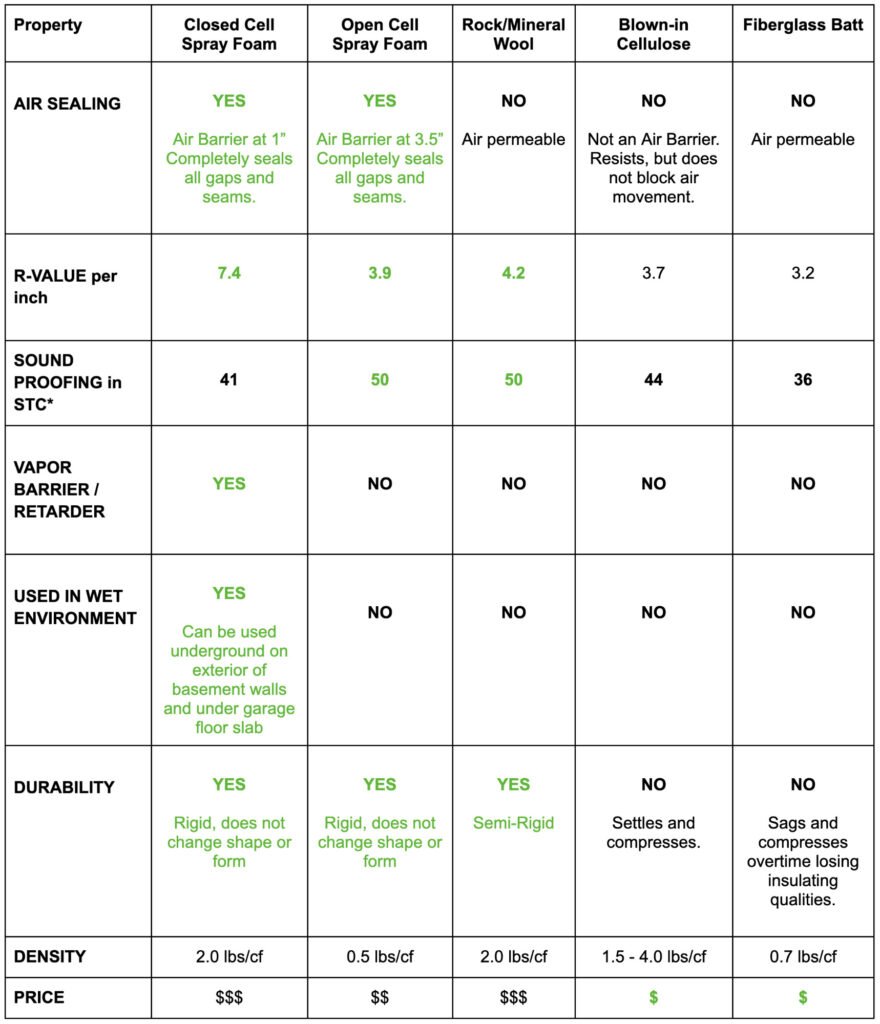This chart summarizes various characteristics of five most common house insulation materials: closed cell spray foam, open cell spray foam, rock wool (a.k.a. mineral wool) blown-in cellulose and fiberglass batt. Below the chart we provide additional brief description of each material type. For additional resources feel free to explore the Learning Center in the menu bar for other helpful articles and videos.
When viewing the chart on a mobile device we recommend turning the device to a landscape view and/or zooming in on the chart.

*Sound Transmission Class (STC) measured in decibels is a rating system that measures how well a building material or partition blocks airborne sound. It’s a single number that’s used to compare the sound isolation performance of different materials. The higher the STC rating, the better the material is at reducing sound.
Closed cell spray foam insulation is a high-performance product known for its rigid texture and superior insulation properties. This type of spray foam is composed of cells that are completely closed, tightly packed and form a barrier against air and moisture infiltration. Each cubic inch of closed cell foam contains millions of tiny, closed cells. Offering one of the highest R-values per inch among insulation types, closed cell spray foam is ideal for use in areas where space is limited but maximum insulation is required. Its strength adds structural integrity to buildings, and its moisture resistance makes it a great option for areas prone to dampness. Although it is more expensive than other materials, the long-term savings on energy costs often justify the investment.
Rock wool, also known as mineral wool or stone wool, is crafted from volcanic rock and slag, producing a robust insulation material that is both fire-resistant and durable. It is available in batts, boards, and loose-fill, providing excellent thermal resistance and soundproofing capabilities. Rock wool is particularly prized for being a good sound insulator and for its high melting point, enhancing fire safety in buildings. Rock wool repels bulk moisture (hydrophobic), but is not a vapor retarder. Meaning that it repels water in liquid form, but not in gaseous form. Its resilience in various environmental conditions and ease of installation make it a preferred choice for projects requiring superior protection and durability.
Blown-in cellulose insulation is composed primarily of recycled paper products, such as newspaper, treated with fire-retardant chemicals. It is an eco-friendly option for homeowners looking to improve their home’s energy efficiency while minimizing environmental impact. Blown-in cellulose is applied using a mechanical blower, allowing it to fill in gaps, crevices, and hard-to-reach spaces in attics and wall cavities. This method creates a dense and effective thermal barrier that reduces air leakage and enhances the overall comfort of the home. Due to its compact nature, cellulose also provides very good sound insulation. However, it can settle over time, which might require periodic checks and maintenance.
Fiberglass insulation is one of the most common and affordable types of insulation, extensively used in both residential and commercial buildings. It is made from very fine strands of glass arranged into a fluffy, wool-like material. Available in batts, rolls, or loose-fill forms, fiberglass has been used since the mid-1950s for insulating walls, floors, and ceilings. It is naturally non-combustible and does help soundproofing. However, fiberglass insulation, while widely used and cost-effective, does come with several disadvantages that must be considered:
1. Limited R-Value Per Inch: compared to some newer insulation technologies, fiberglass has a relatively lower R-value per inch. This means thicker layers may be required to achieve the same level of insulation offered by other materials, potentially limiting its effectiveness in space-constrained applications.
2. Installation Gaps: air gaps can form if the batts or rolls are improperly fitted or if they have been compress within cavities. These gaps reduce insulation efficiency by allowing heat to escape or penetrate the building envelope.
3. Moisture Issues: fiberglass insulation does not inherently repel moisture, meaning that when exposed to water or high humidity, it can absorb moisture. This wetness can decrease its insulating properties and create conditions conducive to mold and mildew growth.
4. Settlement Over Time: over long periods, especially in vertical applications, fiberglass can settle, reducing its thermal effectiveness. This settling can necessitate additional insulation or reapplication to maintain energy efficiency.
At Cloud9 we specialize in installing high performance insulation materials. We are certified by the Building Performance Institute and are qualified to evaluate your property’s energy efficiency offering effective insulation options to fit different budgets.
Contact us today to schedule a free consultation and discover how we can help you achieve peak performance for your home or business.
© Cloud9Home Performance Insulation 2025